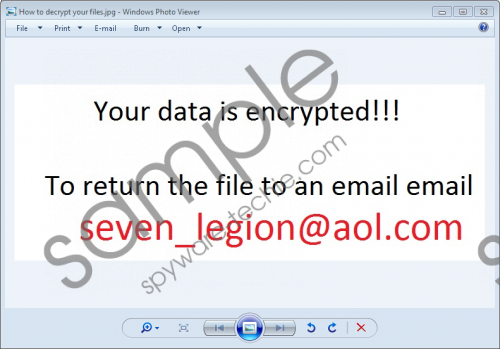Do you know what Seven_legion@aol.com Ransomware is?
Seven_legion@aol.com Ransomware is a devious infection that will encrypt your personal files and order you to pay a ransom in return of their decryption. Although it is possible that the creator behind this infection is capable of providing you with the right decryptor, whether or not that would happen is a gamble. Sure, you might get the decryptor soon after you pay the huge ransom, but it is also possible that you will be duped. It is bad enough to lose your personal files, and losing your money on top of that would be awful. Due to this, we advise that you read this report before you decide whether or not you should pay the ransom. Whatever you decide to do, do not forget to remove Seven_legion@aol.com Ransomware. Even if your files get decrypted, and the infection appears to have been disabled, its malicious components could be used again! So, continue reading and delete the ransomware ASAP.
Our research team informs that Seven_legion@aol.com Ransomware is practically identical to such ransomware infections as Systemdown@india.com Ransomware, Bitcoinrush@imail.com Ransomware, and Melme@india.com Ransomware. Although it is most likely that they were created by different parties, they are using the same source code, which is why they are basically identical. The bad news is that this malware uses an extremely complicated encryption algorithm, RSA. At this point in time, there is no legitimate decrypter that would be able to decipher the encryption, which is exactly why so many malware creators are using the source code. One thing that is unpredictable in regards to this malware is its distribution. While most of these ransomware infections are likely to be spread via corrupted spam emails, other drive-by download and social engineering scam could be used to infiltrate them. Once they are in, they start encrypting the files immediately, and most victims realize that they need to delete Seven_legion@aol.com Ransomware only after it corrupts all files. Seven_legion@aol.com Ransomware screenshot
Seven_legion@aol.com Ransomware screenshot
Scroll down for full removal instructions
Just like all other threats from the family, Seven_legion@aol.com Ransomware is run from a malicious .exe file. It also creates two additional files, "How to decrypt your files.txt" and "How to decrypt your files.jpg". The latter file replaces the Desktop wallpaper, and it might be the first signal of malware. Both the TXT and JPG files push you to email seven_legion@aol.com. If you do, cyber criminals might record your email address, so you better use a new or unused email address. When you get a response, it will include instructions telling you how to pay a ransom, but again, you need to think before following the demands. If you cannot risk losing your money as well as your files, paying the ransom might not be a good idea. If you see no other option, do not get your hopes up about getting the files back. In case you do get in contact with cyber criminals, and they demand an ID number, all you need to do is find an encrypted file and find the ID in the attached extension: .id-[ID].Seven_legion@aol.com.xtbl.
Whether you manage to restore your files from backup, or you lose them for good, you need to delete Seven_legion@aol.com Ransomware from your operating system, and you have several options. We advise implementing anti-malware software because it can take care of all threats and keep the system guarded in the future. Although the ransomware is taking the center stage, it is possible that other treats exist as well. In fact, they could be responsible for downloading the ransomware itself. Obviously, if additional malware exists, and you choose to clean out your operating system manually, you will need to perform additional steps. First, scan your PC to identify the threats you might have to erase. Also, if the guide below is too complicated for you, it is best to rely on anti-malware software instead.
Remove Seven_legion@aol.com Ransomware
- Simultaneously tap Win+E to launch Explorer.
- Enter the directory name (see the list below) into the address bar and Delete the malignant .exe file.
- %ALLUSERSPROFILE%\Start Menu\Programs\Startup\
- %APPDATA%\Microsoft\Windows\Start Menu\Programs\Startup\
- %USERPROFILE%\Microsoft\Windows\Start Menu\Programs\Startup\
- %ALLUSERSPROFILE%\Microsoft\Windows\Start Menu\Programs\Startup\
- %ALLUSERSPROFILE%\Application Data\Microsoft\Windows\Start Menu\Programs\Startup\
- %WINDIR%\System32\
- %WINDIR%\Syswow64\
- Simultaneously tap Win+R to launch RUN.
- Enter regedit.exe to launch Registry Editor.
- In the pane on the left, navigate to HKCU\Control Panel\Desktop.
- Double-click Wallpaper and erase C:\Users\user\how to decrypt your files.jpg.
- Navigate to HKCU\SOFTWARE\Microsoft\Windows\CurrentVersion\Explorer\Wallpapers.
- Double-click BackgroundHistoryPath0 and erase C:\Users\user\how to decrypt your files.jpg.
- Navigate to HKLM\SOFTWARE\Microsoft\Windows\CurrentVersion\Run.
- Delete the value whose value data represents the malignant .exe file.
In non-techie terms:
The malicious Seven_legion@aol.com Ransomware can slither into your operating system without your notice and quietly encrypt all files (except for system files) found. After performing the encryption, this ransomware uses additional files to inform you that you need to email the given address. When you do, you are ordered to pay a ransom, and that is not something we can recommend doing because you could get duped. Unfortunately, there is little anyone can do once the ransomware slithers in, and it is very possible that you will lose your personal files. Whether or not you do, make sure you delete Seven_legion@aol.com Ransomware as soon as possible, and you can use automated malware removal software or follow the guide above to get rid of the ransomware.
